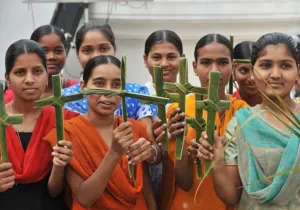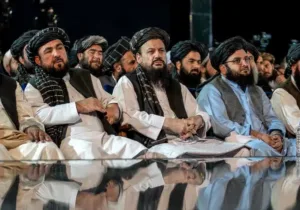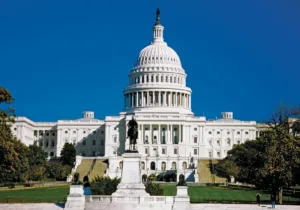August 15th, 2023, marked the seventy-sixth anniversary of India’s independence and so it might be asked: what was Mohandas K. Gandhi’s vision for the vitality of a democratic India? Gandhi himself wanted no part of the “vivisection of India” when the British Raj was partitioned into Pakistan and India. He decried “my life’s work is over” when he witnessed the murder of hundreds of thousands during partition. Still, he still did not give up on peace. The fate of India was in the hands of two men whose minds could not be reconciled: Muhammad Ali Jinnah, leader of the Muslim League, and Gandhi of the Indian National Congress. India might have remained one country, but that did not happen.
Gandhi, holding to unity so dearly, was murdered by the Hindutva-inspired fanatic Nathuram Vinayak Godse. Hindutva is an ideology inspired by opponents of Indian religious unity, such as V.D. Savarkar, whose nationalism centered around Hindus while excluding Muslims. This divisive spirit of Hindutva still haunts India today, and no doubt Gandhi would be restless to challenge it.
India’s independence and Gandhi’s life were celebrated in Richard Attenborough’s film Gandhi, released in 1982. It starred Ben Kingsley as the Mahatma, who gave an Academy-Award winning performance. The film portrays much accurately, but not everything. In it, Gandhi shouts to an angry Hindutva-inspired crowd: “I am a Christian, and a Hindu, a Moslem, and a Jew.” Gandhi did indeed say these words, but it was when his biographer Louis Fischer asked him about a portrait of Christ in the wall of his home. Gandhi had a unique way of affirming all religions, that “God is Truth,” which transcended but also captured the whole family of earthly religions. We are all children of God, in Gandhi’s eyes, celebrating the divine differently. Gandhi believed that “religions are different roads converging on the same point. What does it matter that we take different roads so long as we reach the same goal? In reality, there are as many religions as there are individuals.” Gandhi believed that Hindus, Muslims, and Christians could align under one nation. He fostered this by reading from the Hindu Bhagavad-Gita, the Muslim Quran, and the Christian Bible at his prayer meetings.
History shows a united India could have been possible, though it did not come to pass. The third Mughal emperor Jalal-al-Din Akbar (1542-1605) invited all India’s religions to participate in a great interfaith dialogue. He abolished the non-Muslim tax or jizya, an important precedent for non-sectarian democracy. Yet, the sixth Mughal, Aurangzeb (1618-1707), reimposed the jizya, reigniting religious division. In a power struggle with his brother Dara Shikoh, one with a similar pluralist vision to both Akbar and the latter Gandhi, Aurangzeb defeated Dara. If Akbar and Dara’s vision had more time to gain foothold in India, the divisions leading up to decolonization might have been mitigated. Gandhi believed: “The time has now passed when the followers of one religion can stand and say, ours is the only true religion and all others are false. The growing spirit of toleration towards all religions is a happy augury of the future.” Sadly, this augury has not transpired. Still, for a healthy democracy, learning the possible compatibility of religions is essential.
Another inaccuracy in Attenborough’s 1982 film is with a meeting in Jinnah’s Bombay house. Jinnah is portrayed as backing Gandhi’s call for civil disobedience when in fact he never did. Formerly an advocate of Hindu-Muslim unity in the 1920s, by the 1940s Jinnah had turned against the Indian Nation Congress and Gandhi. Jinnah stated: “I am fully convinced that it (Gandhi’s methods) must lead to disaster . . . that your methods have already caused split and division in almost every institution . . . not only amongst Hindus and Muslims but between Hindus and Hindus and Muslims.” Jinnah preferred to work with constitutional processes and was a political secularist; he abhorred Gandhi’s rhetoric which, though non-violent, had a highly religious conception of Indian society and was borderline revolutionary.
Jinnah had also become trenchantly opposed to a united Hindu-Muslim India:
It is extremely difficult to appreciate why our Hindu friends fail to understand the real nature of Islam and of Hinduism. They are not religions in the strict sense of the word, but they are in fact different and distinct social orders, and it is a dream that the Hindus and Muslims can ever evolve a common nationality. This misconception of one Indian nation has gone far beyond the limits and is the cause of most of our troubles and will lead India to destruction if we fail to revise our notions in time.
This was a complete repudiation of Gandhi’s method and his vision of a united India. Truthfully, there is indication that Jinnah also rejected theocracy. Jinnah announced to Pakistanis:
You are free . . . to go to your temples . . . to go to your mosques or to any other place of worship in this State of Pakistan . . . You may belong to any religion or caste or creed – that has nothing to do with the business of the State . . . We are starting in the days when there is no discrimination between one caste or creed and another. We are starting with this fundamental principle that we are all citizens and equal citizens of one State.
Jinnah and Gandhi may technically have agreed on many of the political principles of a state but could not agree that Hindus and Muslims could work them out together. Could India have remained united, as Gandhi wished? It was possible, but also difficult giving long-standing historic, cultural, and religious divisions. Was Jinnah more realistic? The saga of India really is a tale for all civilization: the tale of sub-groups of a common humanity struggling to work out their political and religious differences. No state or country is immune from the strife that affected India. Gandhi’s idealism that cooperation is possible is as valid today as Jinnah’s concern that such matters are difficult.
Gandhi’s “failure” to get Hindu and Muslim unity is not personal, nor uniquely Indian. It is a lesson to all countries who desire democratic civilization. In history, there are tidal lapses of progress, sometime surging forward towards unity, and at other receding and revealing beaches of division. We should remember Gandhi’s struggle today, for it wasn’t merely about non-violence, but a measure transcending religious differences to make civilization more possible.







 Sponsor a student for Christianity & National Security 2024
Sponsor a student for Christianity & National Security 2024